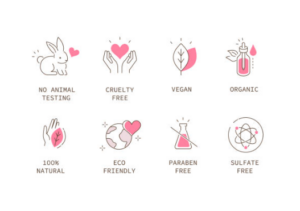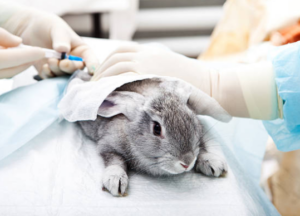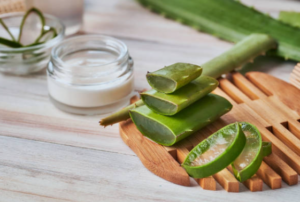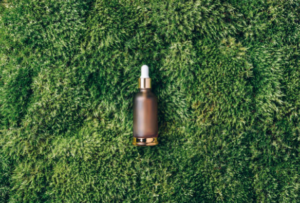More Than Skin Deep

As the beauty industry continues to evolve, ethical considerations play an increasingly vital role in consumers’ purchasing decisions. Two prominent categories, often used interchangeably but distinctly different, are cruelty-free and vegan beauty products. In this comprehensive exploration, we’ll delve into the nuances that separate these two categories while highlighting their shared commitment to ethical practices and animal welfare.
Understanding Cruelty-Free Beauty
Defining Cruelty-Free: Cruelty-free beauty products are those that are developed without subjecting animals to testing, both in the formulation and final product stages. This means the ingredients used and the finished product itself have not been tested on animals. The commitment to cruelty-free practices extends across the entire product development process, emphasizing ethical treatment and respect for animal welfare.
Leaping Bunny Certification: One of the most esteemed and widely recognized certifications for cruelty-free products is the Leaping Bunny certification. Awarded by the Coalition for Consumer Information on Cosmetics (CCIC), this logo signifies that a brand has met stringent cruelty-free standards throughout its entire supply chain. The Leaping Bunny certification ensures that neither the finished product nor its individual components have been tested on animals, providing consumers with a reliable indicator of a brand’s commitment to cruelty-free practices.
No Animal Testing Policies: Brands proclaiming cruelty-free status typically adhere to a strict no animal testing policy. This commitment spans beyond the final product and includes the individual ingredients used in formulations. Companies adopting a cruelty-free stance often collaborate with suppliers and manufacturers who share the same values, ensuring that no aspect of the product development involves animal testing.
Global Cruelty-Free Standards: While cruelty-free standards have become well-established in certain regions, it’s important to note that there is no global consensus on what constitutes cruelty-free practices. Regulations may vary, and some regions may have different definitions or criteria for cruelty-free status. As a result, consumers should be mindful of regional variations and look for certifications or brand-specific policies that align with their ethical values.
Alternatives to Animal Testing: Cruelty-free beauty brands actively explore and utilize alternative testing methods that do not involve animals. These methods include in vitro testing, computer modeling, and human volunteer trials. By investing in these alternatives, cruelty-free brands demonstrate their commitment to advancing the beauty industry without compromising animal welfare.
Educational Initiatives: Many cruelty-free brands engage in educational initiatives to raise awareness about the importance of cruelty-free practices. This may include advocating for regulatory changes, supporting organizations dedicated to ending animal testing, and providing resources to consumers to help them make informed choices. Through these efforts, cruelty-free brands contribute to a broader movement towards a more compassionate and ethical beauty industry.
Transparent Communication: Transparent communication is a hallmark of cruelty-free beauty brands. These brands often provide detailed information on their websites regarding their cruelty-free status, the steps taken to ensure no animal testing, and their stance on ethical sourcing. This transparency empowers consumers to make informed choices and reinforces the brand’s commitment to ethical practices.

Understanding Vegan Beauty
Defining Vegan Beauty: Vegan beauty products go beyond cruelty-free formulations by excluding any animal-derived ingredients in their entirety. This commitment extends not only to eliminating animal testing but also to avoiding ingredients such as beeswax, lanolin, carmine, collagen, and other substances derived from animals. Vegan beauty emphasizes a plant-based and cruelty-free approach to product development.
Ingredient Transparency: Vegan beauty brands prioritize ingredient transparency to empower consumers with a clear understanding of the components in their products. This transparency extends to providing information about the sourcing and processing of ingredients, ensuring that consumers can make informed choices based on their ethical preferences. Ingredient lists are often prominently featured on product packaging and brand websites.
PETA’s Beauty Without Bunnies Certification: The People for the Ethical Treatment of Animals (PETA) offers the Beauty Without Bunnies certification to vegan brands. This certification signifies that a brand is not only cruelty-free but also completely vegan. Brands with this certification adhere to PETA’s rigorous standards, ensuring that no animal-derived ingredients are used in their products, and no animal testing is conducted at any stage of production.
Exclusion of Animal-Derived Ingredients: Vegan beauty products strictly exclude ingredients sourced from animals. This includes common animal-derived components like beeswax, honey, lanolin (wool grease), and carmine (a red pigment derived from crushed insects). By choosing vegan beauty, consumers actively support a cruelty-free and plant-based lifestyle, contributing to the growing demand for ethical and sustainable beauty alternatives.
Innovative Formulations: Vegan beauty brands often embrace innovation in their formulations by seeking plant-based alternatives to traditional animal-derived ingredients. This commitment to innovation not only aligns with ethical principles but also fosters creativity within the beauty industry, leading to the development of effective, cruelty-free, and vegan products.
Focus on Ethical Sourcing: Vegan beauty brands frequently emphasize ethical sourcing of ingredients. This includes supporting fair trade practices, environmentally sustainable agriculture, and ensuring that the production of plant-based ingredients does not contribute to deforestation or harm to ecosystems. By prioritizing ethical sourcing, vegan beauty brands address not only animal welfare but also broader environmental and social concerns.
Certification Verification: Consumers seeking assurance that a product is both cruelty-free and vegan can look for certifications such as PETA’s Beauty Without Bunnies. These certifications serve as a reliable indicator that a brand has undergone thorough scrutiny to meet the highest standards of ethical beauty practices. Brands often display these certifications on their packaging, websites, or marketing materials.
Consumer Education: Vegan beauty brands actively engage in consumer education initiatives. These efforts aim to raise awareness about the impact of animal-derived ingredients, promote the benefits of plant-based alternatives, and encourage a mindful approach to beauty choices. Educational content may include information on the ethical considerations of vegan beauty, ingredient guides, and the positive environmental impact of choosing plant-based products.

Differences Between Cruelty-Free and Vegan
Cruelty-Free Doesn’t Guarantee Vegan: One of the primary distinctions between cruelty-free and vegan beauty lies in the ingredient sourcing. While cruelty-free products ensure that neither the final product nor its individual components have been tested on animals, they may still contain animal-derived ingredients. These ingredients could include substances like beeswax, lanolin, or carmine, which are obtained from animals but do not involve animal testing in their production. Therefore, a product labeled as cruelty-free does not automatically imply that it is also vegan, making it crucial for consumers to scrutinize ingredient lists.
Vegan Products Can Be Cruelty-Free, but Not Vice Versa: A key point to remember is that all vegan beauty products are inherently cruelty-free because they avoid animal-derived ingredients. However, the reverse is not always true; a product labeled as cruelty-free may still contain non-vegan ingredients. For consumers seeking both cruelty-free and vegan options, it’s advisable to look for products with dual certifications or those explicitly labeled as both cruelty-free and vegan.
Ingredient Complexity: Understanding the differences between cruelty-free and vegan beauty requires a nuanced understanding of ingredient complexity. Some ingredients, while not tested on animals, may be derived from animal sources. Conversely, certain plant-derived ingredients may be present in cruelty-free products but might not be considered vegan due to the inclusion of other animal-derived components.
Common Non-Vegan Ingredients: Cruelty-free products may include ingredients sourced from animals, such as beeswax (used in lip balms and cosmetics), lanolin (derived from sheep’s wool, often found in moisturizers), and carmine (a red pigment obtained from crushed insects, used in some lip products and blushes). These ingredients, while cruelty-free in terms of testing, do not align with vegan principles.
Egg-Derived Ingredients: Some beauty products may contain ingredients derived from eggs, such as albumen (egg white protein). While these ingredients do not involve animal testing, they are not considered vegan. For those avoiding animal by-products altogether, it’s essential to be vigilant about these less-obvious ingredients.
Geographic Variations in Definitions: The definitions of cruelty-free and vegan can vary based on geographic regions and regulatory standards. Some regions may have distinct criteria for what constitutes cruelty-free or vegan, leading to potential confusion for consumers. Staying informed about regional nuances and looking for certifications can help navigate these variations.
Ethical Considerations Beyond Animal Testing: While cruelty-free primarily addresses animal testing concerns, vegan beauty extends its ethical considerations beyond testing to encompass the sourcing of all ingredients. This includes avoiding not only animal testing but also the use of any animal-derived substances, aligning with a broader ethical commitment to a plant-based lifestyle.
Consumer Education and Awareness: Recognizing the differences between cruelty-free and vegan beauty products requires consumer education and awareness. Brands play a crucial role in communicating their values transparently, and consumers can empower themselves by actively seeking information about a product’s ingredients and certifications.

Environmental Impact
Sustainable Practices: Both cruelty-free and vegan beauty brands often prioritize sustainable practices. This includes eco-friendly packaging, responsibly sourced ingredients, and minimizing the overall environmental footprint of their products.
Ethical Sourcing: Many brands in these categories emphasize ethical sourcing of ingredients, supporting fair trade practices and ensuring that their supply chain aligns with principles of social responsibility.
Certifications and Logos: To make informed choices, consumers can look for recognized certifications and logos that indicate a product’s cruelty-free or vegan status. Leaping Bunny and PETA’s Beauty Without Bunnies logos are widely acknowledged symbols of ethical beauty practices.
Educational Resources: Empowering consumers with knowledge is key. Brands often provide information on their websites regarding their cruelty-free and vegan status, ingredient lists, and the steps taken to ensure ethical practices. Consumers can use these resources to make conscious decisions.
In the ever-expanding landscape of beauty products, the choices we make as consumers can contribute to a positive impact on animals and the environment. Cruelty-free and vegan beauty products, while distinct, converge on the common ground of ethical practices. By understanding the differences and similarities between these categories, we empower ourselves to make choices that align with our values, fostering a beauty industry that prioritizes compassion, transparency, and sustainability.

